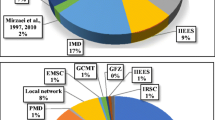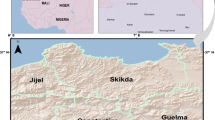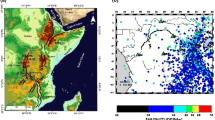Abstract
In this study, an updated earthquake catalogue and seismic source model for Pakistan region (bounded by latitude 20°–40° N and longitude 58°–83° E) are developed. The updated catalogue consists of published historical (10 to 1900 CE) and instrumental earthquake events (1900 to 2018 CE) with moment magnitude (Mw) ≥ 4.0. For this purpose, several international and national databases were accessed for collecting the historical and instrumentally recorded earthquake events occurred in the study region. The collected data from various sources were homogenized in a single moment magnitude scale. Several empirical relations were developed for conversion of earthquake magnitude in other scales to moment magnitude. The datasets are homogenized, declustered, and processed to evaluate complete intervals for different magnitude ranges. Using the developed catalogue and considering the seismo-tectonic features of the region, a number of shallow and deep area source zones are delineated to develop an improved seismic source model for Pakistan. The source model for spatially smoothed background seismicity is also developed using the updated catalogue. The developed catalogue and seismic source models can be reliably used to conduct an updated probabilistic seismic hazard assessment of Pakistan.
















Similar content being viewed by others
References
Kazmi, A.H.; Rana, R.: Tectonic map of Pakistan: Ministry of Petroleum and Natural Resources. In: Geological Survey of Pakistan (1982)
Chen, Z.; Burchfiel, B.C.; Liu, Y.; King, R.W.; Royden, L.H.; Tang, W.; Wang, E.; Zhao, J.; Zhang, X.: Global positioning system measurements from eastern Tibet and their implications for India/Eurasia intercontinental deformation. J. Geophys. Res. Atmos. 105(B7), 16215–16227 (2000). https://doi.org/10.1029/2000jb900092
Khan, M.A.; Bendick, R.; Bhat, M.I.; Bilham, R.; Kakar, D.M.; Khan, S.F.; Lodi, S.H.; Qazi, M.S.; Singh, B.; Szeliga, W.: Preliminary geodetic constraints on plate boundary deformation on the western edge of the Indian plate from TriGGnet (Tri-University GPS geodesy network). J. Himal. Earth Sci 41, 71–87 (2008)
Molnar, P.; Tapponnier, P.: Relation of the tectonics of eastern China to the India–Eurasia collision: application of slip-line field theory to large-scale continental tectonics. Geology 5(4), 212–216 (1977)
Perry, M.; Kakar, N.; Ischuk, A.; Metzger, S.; Bendick, R.; Molnar, P.; Mohadjer, S.: Little geodetic evidence for localized Indian subduction in the Pamir-Hindu Kush of Central Asia. Geophys. Res. Lett. 46(1), 109–118 (2019). https://doi.org/10.1029/2018GL080065
Seeber, L.; Armbruster, J.G.; Quittmeyer, R.C.: Seismicity and continental subduction in the Himalayan arc. In: Gupta, H.K.; Delany, F.M. (Eds.) Zagros Hindu Kush Himalaya Geodynamic Evolution, Vol. 3, pp. 215–242. American Geophysical Union, Washington DC (1981)
Khwaja, A.A.; Jan, M.Q.: The 8 October 2005 Muzaffarabad earthquake: Preliminary seismological investigations and probabilistic estimation of peak ground accelerations. Curr. Sci. Bangalore, 1158–1166 (2008)
Negredo, A.M.; Replumaz, A.; Villaseñor, A.; Guillot, S.: Modeling the evolution of continental subduction processes in the Pamir-Hindu Kush region. Earth Planet. Sci. Lett. 259(1–2), 212–225 (2007). https://doi.org/10.1016/j.epsl.2007.04.043
Quittmeyer, R.C.; Farah, A.; Jacob, K.H.: The seismicity of Pakistan and its relation to surface faults. Geodyn. Pak. 271–284 (1979)
Apel, E.T.; Bürgmann, R.; Banerjee, P.: Geodetically constraining Indian plate motion and implications for plate boundary deformation (2006)
Farhoudi, G.; Karig, D.: Makran of Iran and Pakistan as an active arc system. Geology 5(11), 664–668 (1977). https://doi.org/10.1130/0091-7613(1977)5-664
Shearman, D.; Walker, G.; Booth, B.; Falcon, N.: The geological evolution of southern Iran: the report of the Iranian Makran expedition. Geogr. J. 142, 393–410 (1976). https://doi.org/10.2307/1795293
Stoneley, R.: Evolution of the continental margins bounding a former southern Tethys. In: Burk, Creighton A.; Drake, Charles L. (Eds.) The Geology of Continental Margins, pp. 889–903. Springer, Berlin (1974)
Zarifi, Z.; Raeesi, M.: Heterogeneous coupling along Makran subduction zone. In: AGU Fall Meeting Abstracts (2010)
Fujiwara, S.; Tobita, M.; Sato, H.P.; Ozawa, S.; Une, H.; Koarai, M.; Nakai, H.; Fujiwara, M.; Yarai, H.; Nishimura, T.: Satellite data gives snapshot of the 2005 Pakistan earthquake. Eos Trans. Am. Geophys. Union 87(7), 73–77 (2006). https://doi.org/10.1029/2006EO070001
Kaneda, H.; Nakata, T.; Tsutsumi, H.; Kondo, H.; Sugito, N.; Awata, Y.; Akhtar, S.S.; Majid, A.; Khattak, W.; Awan, A.A.: Surface rupture of the 2005 Kashmir, Pakistan, earthquake and its active tectonic implications. Bull. Seismol. Soc. Am. 98(2), 521–557 (2008). https://doi.org/10.1785/0120070073
Durrani, A.J.; Elnashai, A.S.; Hashash, Y.M.A.; Kim, S.J.; Masud, A.: The Kashmir earthquake of October 08, 2005, p. 51 (2005)
Khan, S.; Waseem, M.; Khan, M.A.; Ahmed, W.: Updated earthquake catalogue for seismic hazard analysis in Pakistan. J. Seismolog. 22(4), 841–861 (2018). https://doi.org/10.1007/s10950-018-9736-y
NESPAK: Building code of Pakistan—seismic hazard evaluation studies. In. Ministry of Housing and Works, Government of Pakistan (2007)
Zare, M.; Amini, H.; Yazdi, P.; Sesetyan, K.; Demircioglu, M.B.; Kalafat, D.; Erdik, M.; Giardini, D.; Khan, M.A.; Tsereteli, N.: Recent developments of the Middle East catalog. J. Seismolog. 18(4), 749–772 (2014). https://doi.org/10.1007/s10950-014-9444-1
PBC: Buliding code of Pakistan, Seismic Provision-2007. In: Ministry of Housing and Works, Islamabad, Pakistan (2007)
ISC: International Seismological Centre. On-line Bulletin (2019)
USGS: USGS. https://earthquake.usgs.gov/earthquakes/search/ (2019). Accessed 10 Apr 2019
Council, N.R.: Review of NOAA’s national geophysical data center. National Academies Press, Washington DC (2018)
Dziewonski, A.; Chou, T.; Woodhouse, J.: Determination of earthquake source parameters from waveform data for studies of global and regional seismicity. J. Geophys. Res. Solid Earth (1981). https://doi.org/10.1029/JB086iB04p02825
Ekström, G.; Nettles, M.; Dziewoński, A.: The global CMT project 2004–2010: centroid-moment tensors for 13,017 earthquakes. Phys. Earth Planet. Inter. 200, 1–9 (2012). https://doi.org/10.1016/J.PEPI.2012.04.002
Ambraseys, N.: Reappraisal of north-Indian earthquakes at the turn of the 20th century. Curr. Sci. Bangalore 79(9), 1237–1250 (2000)
Ambraseys, N.; Bilham, R.: The tectonic setting of Bamiyan and seismicity in and near Afghanistan for the past twelve centuries. In: Margottini, Claudio (Ed.) After the Destruction of Giant Buddha Statues in Bamiyan (Afghanistan) in 2001, pp. 101–152. Springer, Berlin (2014)
Ambraseys, N.N.; Douglas, J.: Magnitude calibration of north Indian earthquakes. Geophys. J. Int. 159(1), 165–206 (2004). https://doi.org/10.1111/j.1365-246x.2004.02323.x
Quittmeyer, R.; Jacob, K.: Historical and modern seismicity of Pakistan, Afghanistan, northwestern India, and southeastern Iran. Bull. Seismol. Soc. Am. 69(3), 773–823 (1979)
Rafi, Z.; Lindholm, C.; Bungum, H.; Laghari, A.; Ahmed, N.: Probabilistic seismic hazard of Pakistan, Azad-Jammu Kashmir. Nat Hazards 61(3), 1317–1354 (2012). https://doi.org/10.1007/s11069-011-9984-4
Scordilis, E.: Empirical global relations converting MS and mb to moment magnitude. J. Seismolog. 10(2), 225–236 (2006). https://doi.org/10.1007/s10950-006-9012-4
Yadav, R.; Bormann, P.; Rastogi, B.; Das, M.; Chopra, S.: A homogeneous and complete earthquake catalog for northeast India and the adjoining region. Seismol. Res. Lett. 80(4), 609–627 (2009)
Lolli, B.; Gasperini, P.; Vannucci, G.: Erratum: Empirical conversion between teleseismic magnitudes (mb and Ms) and moment magnitude (Mw) at the Global, Euro-Mediterranean and Italian scale. Geophys. J. Int. 200(1), 199–199 (2014). https://doi.org/10.1093/gji/ggu385
Akkar, S.; Çağnan, Z.; Yenier, E.; Erdoğan, Ö.; Sandıkkaya, M.A.; Gülkan, P.: The recently compiled Turkish strong motion database: preliminary investigation for seismological parameters. J. Seismolog. 14(3), 457–479 (2010). https://doi.org/10.1007/s10950-009-9176-9
Gardner, J.; Knopoff, L.: Is the sequence of earthquakes in Southern California, with aftershocks removed, Poissonian? Bull. Seismol. Soc. Am. 64(5), 1363–1367 (1974)
Reasenberg, P.: Second-order moment of central California seismicity, 1969–1982. J. Geophys. Res. 90(B7), 5479–5495 (1985). https://doi.org/10.1029/JB090iB07p05479
Uhrhammer, R.: Characteristics of northern and central California seismicity. Earthq. Notes 57(1), 21 (1986)
Wiemer, S.: A software package to analyze seismicity: ZMAP. Seismol. Res. Lett. 72(3), 373–382 (2001). https://doi.org/10.1785/gssrl.72.3.373
Rydelek, P.A.; Sacks, I.S.: Testing the completeness of earthquake catalogues and the hypothesis of self-similarity. Nature 337(6204), 251 (1989)
Tinti, S.; Mulargia, F.: Completeness analysis of a seismic catalog. Ann. Geophys. 3, 407–414 (1985)
Stepp, J.: Analysis of completeness of the earthquake sample in the Puget Sound area. In: NOAA Tech. Report ERL 267-ESL30, Boulder, Colorado (1973)
Woessner, J.; Wiemer, S.: Assessing the quality of earthquake catalogues: estimating the magnitude of completeness and its uncertainty. Bull. Seismol. Soc. Am. 95(2), 684–698 (2005)
Gutenberg, B.; Richter, C.F.: Frequency of earthquakes in California. Bull. Seismol. Soc. Am. 34(4), 185–188 (1944)
Pagani, M.; Monelli, D.; Weatherill, G.; Danciu, L.; Crowley, H.; Silva, V.; Henshaw, P.; Butler, L.; Nastasi, M.; Panzeri, L.: OpenQuake engine: an open hazard (and risk) software for the global earthquake model. Seismol. Res. Lett. 85(3), 692–702 (2014). https://doi.org/10.1785/0220130087
Tichelaar, B.W.; Ruff, L.J.: Depth of seismic coupling along subduction zones. J. Geophys. Res. Solid Earth. 98(B2), 2017–2037 (1993). https://doi.org/10.1029/92jb02045
Scholz, C.H.: The mechanics of earthquakes and faulting. Cambridge university press, (2019)
Maggi, A.; Priestley, K.; Jackson, J.: Focal depths of moderate and large size earthquakes in Iran. J. Seismolog. 4(2–3), 1–10 (2002)
Yano, T.E.; Takeda, T.; Matsubara, M.; Shiomi, K.: Japan unified high-resolution relocated catalog for earthquakes (JUICE): crustal seismicity beneath the Japanese Islands. Tectonophysics 702, 19–28 (2017). https://doi.org/10.1016/j.tecto.2017.02.017
PMD, NORSAR: Seismic hazard analysis and zonation of Pakistan, Azad Jammu and Kashmir. Pakistan Meteorological Department (2007)
Byrne, D.E.; Sykes, L.R.; Davis, D.M.: Great thrust earthquakes and aseismic slip along the plate boundary of the Makran subduction zone. J. Geophys. Res. Solid Earth 97(B1), 449–478 (1992). https://doi.org/10.1029/91jb02165
El-Hussain, I.; Al-Shijbi, Y.; Deif, A.; Mohamed, A.; Ezzelarab, M.: Develo** a seismic source model for the Arabian Plate. Arab. J. Geosci. 11(15), 435 (2018)
Danciu, L.; Şeşetyan, K.; Demircioglu, M.; Gülen, L.; Zare, M.; Basili, R.; Elias, A.; Adamia, S.; Tsereteli, N.; Yalçın, H.; Utkucu, M.; Khan, M.A.; Sayab, M.; Hessami, K.; Rovida, A.N.; Stucchi, M.; Burg, J.-P.; Karakhanian, A.; Babayan, H.; Avanesyan, M.; Mammadli, T.; Al-Qaryouti, M.; Kalafat, D.; Varazanashvili, O.; Erdik, M.; Giardini, D.: The 2014 earthquake model of the Middle East: seismogenic sources. Bull. Earthq. Eng. 16(8), 3465–3496 (2018). https://doi.org/10.1007/s10518-017-0096-8
Zhang, P.; Yang, Z.; Gupta, H.K.; Bhatia, S.C.; Shedlock, K.M.: Global seismic hazard assessment program (GSHAP) in continental Asia (1999)
Aki, K.: Probabilistic seismic hazard analysis. National Academies, (1988)
Giardini, D.; Grünthal, G.; Shedlock, K.M.; Zhang, P.: The GSHAP global seismic hazard map. Ann. Geophys. 42(6) (1999)
Aki, K.: Maximum likelihood estimate of b in the formula log N= a-bM and its confidence limits. Bull. Earthq. Res. Inst. Tokyo Univ. 43, 237–239 (1965)
Frankel, A.: Map** seismic hazard in the central and eastern United States. Seismol. Res. Lett. 66(4), 8–21 (1995). https://doi.org/10.1785/gssrl.66.4.8
Ornthammarath, T.; Warnitchai, P.; Worakanchana, K.; Zaman, S.; Sigbjörnsson, R.; Lai, C.G.: Probabilistic seismic hazard assessment for Thailand. Bull. Earthq. Eng. 9(2), 367–394 (2011). https://doi.org/10.1007/s10518-010-9197-3
Petersen, M.D.; Moschetti, M.P.; Powers, P.M.; Mueller, C.S.; Haller, K.M.; Frankel, A.D.; Zeng, Y.; Rezaeian, S.; Harmsen, S.C.; Boyd, O.S.: The 2014 United States national seismic hazard model. Earthq. Spectra 31(S1), S1–S30 (2015)
Stein, S.; Geller, R.J.; Liu, M.: Why earthquake hazard maps often fail and what to do about it. Tectonophysics 562, 1–25 (2012). https://doi.org/10.1016/j.tecto.2012.06.047
Weichert, D.H.: Estimation of the earthquake recurrence parameters for unequal observation periods for different magnitudes. Bull. Seismol. Soc. Am. 70(4), 1337–1346 (1980)
Ali, M.: Seismic Hazard Analysis of Pakistan. Pakistan Institute of Engineering & Applied Sciences, Nilore, Islamabad, Pakistan (2011)
Bird, P.: An updated digital model of plate boundaries. Geophys. Geosyst. Geochem. (2003). https://doi.org/10.1029/2001gc000252
Jade, S.: Estimates of plate velocity and crustal deformation in the Indian subcontinent using GPS geodesy. Current Science-Bangalore 1443–1448 (2004)
Sella, G.F.; Dixon, T.H.; Mao, A.: REVEL: a model for Recent plate velocities from space geodesy. J. Geophys. Res. 107(B4), ETG11-1-ETG11–30 (2002). https://doi.org/10.1029/2000jb000033
Vernant, P.; Nilforoushan, F.; Hatzfeld, D.; Abbassi, M.R.; Vigny, C.; Masson, F.; Nankali, H.; Martinod, J.; Ashtiani, A.; Bayer, R.; Tavakoli, F.; Chéry, J.: Present-day crustal deformation and plate kinematics in the Middle East constrained by GPS measurements in Iran and northern Oman. Geophys. J. Int. 157(1), 381–398 (2004). https://doi.org/10.1111/j.1365-246X.2004.02222.x%JGeophysicalJournalInternational
van Stiphout, T.; Zhuang, J.; Marsan, D.: Seismicity declustering. Community Online Resource for Statistical Seismicity Analysis 10(1) (2012)
Author information
Authors and Affiliations
Corresponding author
Appendices
Appendix: Data Sources
The data sources used for the compilation of earthquake catalogue comprises of the available literature, international databases, and local databases. Information about these sources are available online, but a brief introduction of these sources is presented here.
International Sources
-
(a)
International Seismological Centre (ISC)
The ISC http://www.isc.ac.uk/iscbulletin/search/catalogue/ is established in 1964, carrying the work of its predecessor International Seismological Summary (ISS). The ISS published its first bulletin in 1918. ISC is the international archive for reliable earthquake events. It contains all the data from PDE and hundreds of other regional and local sources. The reviewed earthquake’s origin by ISC is considered most reliable [33]. About 10,000 events on average are reviewed per month, in which approximately 40% events are manually reviewed.
-
(b)
Preliminary Determination of Epicenters (PDE)
PDE is the archival of the USGS earthquake catalogue. It contains the origin, magnitude, and arrival time of earthquake events located by the National Earthquake Information Centre (NEIC) and other contributing U.S national and foreign sources. In 1940, NEIC produced its first monthly publication, which was called the Preliminary Determination of Epicenter or PDE. The NEIC established in 1966 by the Environmental Science Services Administration (ESSA) is likely to report the origin, time, and size of earthquakes rapidly worldwide.
-
(c)
Global Centroid Moment Tensor (GCMT)
The project was started by Adam Dziewonski at Harvard University by the name Harvard CMT project from 1982 to 2006. After 2006, the research moves forward under the name “The Global Centroid Moment Tensor.” The project has the aim to calculate CMT solutions for events having magnitude greater than \({M}_{w}= 5.5\). The catalogue of GCMT can be accessed online at http://www.globalcmt.org.
Local Sources
In Pakistan, the local seismic station’s network started working back in 1954 with the installation of World Wide Standard Seismographic Network (WWSSN) by United States Geological Survey (USGS). In 1975, the Micro Seismic Study Program (MSSP) under the Pakistan Atomic Energy Commission (PAEC) installed a seismic stations network. This network comprises of 30 seismic stations all over Pakistan. After the devastating 2005 Kashmir earthquake, the Pakistan Metrological Department (PMD) decided to expand its seismic station’s network by installing the broadband sensors and accelerometers.
-
(a)
National Geophysical Data Centre (NGDC)
The National Geophysical Data Centre provides important historical earthquake events ranges in date from 2150 BCE to the present. The events are compiled from the previous literature, local and worldwide catalogues, and single event reports. Earthquake origin information of the recent historical events is obtained from the PDE. Local Sources.
-
(b)
Pakistan Meteorological Department (PMD):
The Pakistan Meteorological Department (PMD) started recording earthquake events in 1974 in Pakistan and nearby areas. The PMD provides 58 events for the period of \(\mathrm{AD}\,25-1905\,\mathrm{CE}\) [63]. Many of those are extracted from the catalogue of [30]. PMD has installed twenty seismic monitoring stations all over the Pakistan and Azad Jammu & Kashmir. These stations contain broadband (120 s) sensors. PMD central recording stations are located at Karachi and Islamabad and connected through satellite communication system with all other stations. PMD has also started a programme for the installation of a short period (1 s) sensors for the close monitoring of fault and local seismicity. There is also a Global Seismographic Network (GSN) station located in Islamabad, Nilore. The Global Seismographic Network is a digital network of seismological and geophysical sensors, connected through a telecommunications network, used for monitoring, research, and education. GSN is developed by the partnership of the USGS, the National Science Foundation (NSF), and the Incorporated Research Institutions for Seismology (IRIS). The GSN has 150 modern seismic stations all over the world. GSN data are stored in the IRIS Data Management Centre.
-
(c)
Water and Power Development Authority (WAPDA)
Water and Power Development Authority (WAPDA) established a seismic network of nine short periods, VHF radio telemetered stations in 1973 around Tarbela dam with the help of Lamont Doherty Geological Observatory of Columbia University, USA. Now, Wapda’s seismic monitoring system consists of 29 online stations powered up by the solar system and connected to Tarbela data centre via the V-sat communication system. Ten online stations around the Tarbela dam project, six online stations around Dasu dam project, three online stations around Bunji dam project, and ten online stations around Basha dam.
Rights and permissions
About this article
Cite this article
Rahman, A.u., Rasheed, A., Najam, F.A. et al. An Updated Earthquake Catalogue and Source Model for Seismic Hazard Analysis of Pakistan. Arab J Sci Eng 46, 5219–5241 (2021). https://doi.org/10.1007/s13369-021-05439-4
Received:
Accepted:
Published:
Issue Date:
DOI: https://doi.org/10.1007/s13369-021-05439-4




